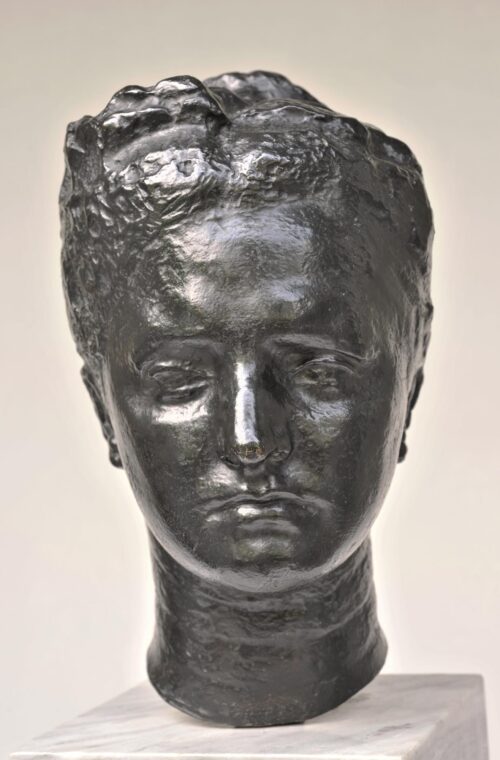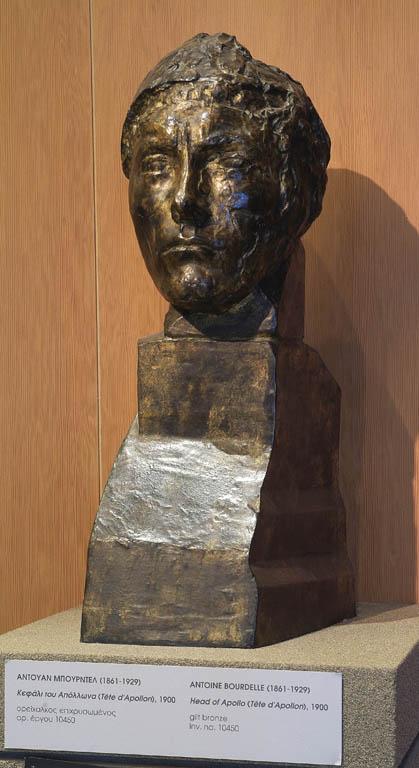
Bourdelle Emile-Antoine (1861 - 1929)
Pallas Athena, [after 1889]
The son of a furniture maker, Emile-Antoine Bourdelle quit school in 1874 to work with his father. From 1876 to 1884 he studied at the School of Fine Arts in Toulouse on scholarship from the Municipality of Montauban. In 1884 he went to Paris, where he was accepted at the School of Fine Arts. For a period time he attended classes at the atelier of Alexandre Falguiere, a particularly successful and productive realist neo-Baroque sculptor with a substantial number of official commissions for public monuments. However, this academic training was incompatible with the concerns of the young Bourdelle, who soon left the School. He subsequently rented a studio in Montparnasse and began working on his own. Jules Dalou, sculptor of the impressive group composition “Triumph of the Republic” (Place de la Nation in Paris) lived nearby. Bourdelle admired him and frequently sought his advice.
In 1897 Bourdelle received his first official commission to create a monument to the fallen in Montauban. The monument committee approved the model on the intervention of Rodin, who fervently supported its acceptance. Bourdelle had met Rodin in 1893 and worked with him until 1908, carving the latter’s models into marble. His first creative period is clearly influenced by Rodin’s work, who introduced him to the forms of ancient sculpture. But Bourdelle’s restless spirit and his need for a more personal expression gradually led him away from the influence of his former teachers and as well as Rodin. This shift in orientation manifested itself in the head of the “Warrior Apollo” (1900) and in the torso of the “Pallas Athena” (1898-1905, which he rendered frontally, relying on schematization, clear planes, and the austere expression characteristic of Archaic-period sculpture. Living in a transitional era that was filled with unease, the questioning of traditional means of expression, and the exploration of new directions, Bourdelle ended up focusing on the various periods of Greek antiquity to provide him with ongoing inspiration. His association with the symbolist poets and his friendship with the Greek-French poet Jean Moreas also played a part in this choice. The influences of Rodin’s sculpture and ancient art, which he combined in the Montauban monument in a personal expressionistic manner, and the eclectic adaptation of the ideals of ancient art, ended up as a synthetic style in which confusion is subjugated by order. This style, which Bourdelle called “organized turmoil,” became the characteristic feature of his art.
Another area to which Bourdelle turned his attention was monumental works, both free-standing and combined with architecture. With the large commissions he received, he contributed significantly to the revival of monumental sculpture, among the most eminent of these being the relief decoration on facade of the Theatre des Champs-Elysees. The exterior decoration in particular, on the theme of Apollo and the Muses modeled after the sculpture of ancient Olympia and based on the teachings of Archaic art and the austere order, is the strongest manifestation of the artist’s convictions that sculpture is an inextricable element of architecture.
Besides mythological themes and monumental group compositions, Bourdelle carved a sizeable number of portrait busts of his predecessors and contemporaries. Although these works show a stylistic polymorphism, they clearly reference ancient models. His restless spirit also expressed itself in a host of Hellenistic-influenced figurines, which he created independently of his commissions, as well as in his thousands of drawings, the majority inspired by Greek mythology. Distinguished among these are the drawings for the illustration of the “Hundred Greek Epigrams” from the “Palatine Anthology”, which was never published, and fifteen terracotta reliefs that were engraved by J.L. Perrichon to illustrate Georges Clemenceau’s “Demosthenes” in 1929.
Bourdelle’s philhellenism also marked his personal life. In 1911 in a second marriage he wed his Greek pupil Cleopatra Sevastou. Although he never managed to visit Greece, he expressed his philhellenic sentiments in a variety of ways. He became personally acquainted with the prominent Greek statesman Eleftherios Venizelos, and was a major actor in the aid campaigns in the Balkan Wars. He also launched an appeal for the return of the ancient treasures.
In addition, Bourdelle became a famous teacher, turning his studio into the Academie de la Grande-Chaumiere in 1909 and maintaining it until his death. Bella Raftopoulou, Kostis Papachristopoulos, Georgios Kastriotis, and primarily Thanasis Apartis were among his Greek students. These artists brought Bourdelle’s teachings back to Greece and played a role in the return to the ideals of ancient art.
His artistic activity also included participation in important exhibitions. Beginning in 1884 he took part in the Salon des Artistes Francais, and from 1891 in the Salon de la Societe Nationale des Beaux Arts, where he achieved his first triumph in 1910 with “Hercules Archer”. In 1914 he represented France in the Venice Biennale; in 1923 he helped found the Salon des Tuileries; and in 1925 he took part in the International Exhibition of Decorative Arts in Paris and exhibited in the United States and Japan. Retrospectives of his work were organized in 1928 at the Palais des Beaux Arts in Brussels, and two years after his death, in 1931, at the Orangerie in Paris. His honorary titles include the award of knighthood in 1909 and admission into the Royal Order of the Legion of Honor in 1919. In 1948 his studio in Montparnasse was converted into a museum.

Pallas Athena, [after 1889]

Head of Apollo (Warrior Apollo), 1900

We use cookies to make our site work properly, to personalize content and ads, to provide social media features and to analyze our traffic. We also share information about how you use our site with our social media, advertising and analytics partners. Read the Cookies Policy.
These cookies are necessary for the website to function and cannot be switched off in our systems. They are usually only set in response to actions made by you which amount to a request for services, such as setting your privacy preferences, logging in or filling in forms. You can set your browser to block or alert you about these cookies, but some parts of the site will not then work. These cookies do not store any personally identifiable information.
If you disable this cookie, we will not be able to save your preferences. This means that every time you visit this website you will need to enable or disable cookies again.
These cookies tell us about how you use the site and they help us to make it better. For example these cookies count the number of visitors to our website and see how visitors move around when they are using it. This helps us to improve the way our site works, for example, by ensuring that users find what they are looking for easily. Our website uses Google Analytics for statistics reporting.
Please enable Strictly Necessary Cookies first so that we can save your preferences!